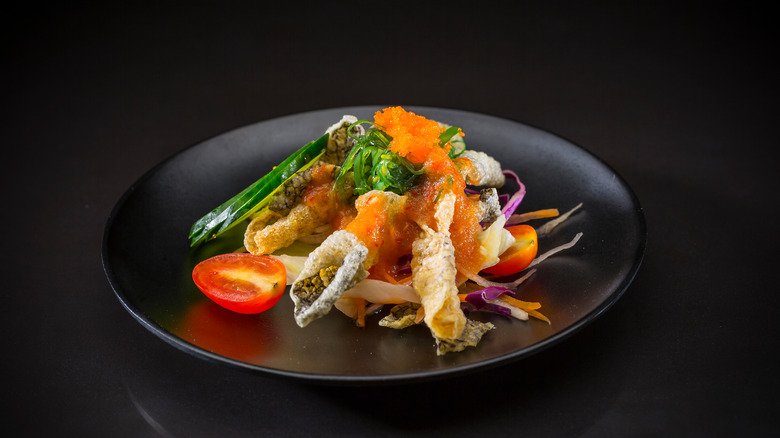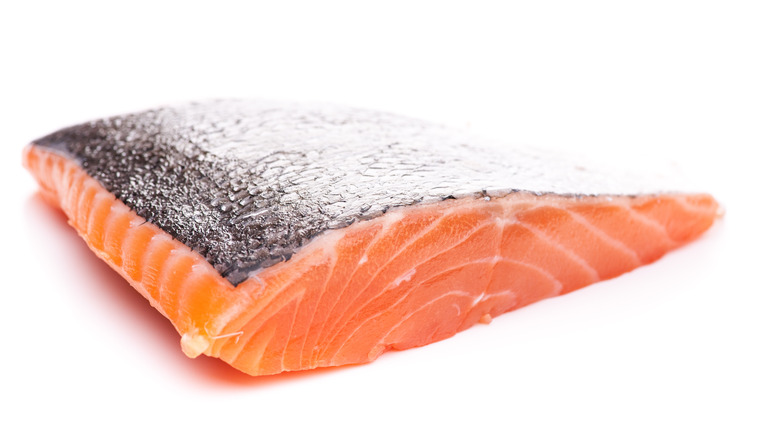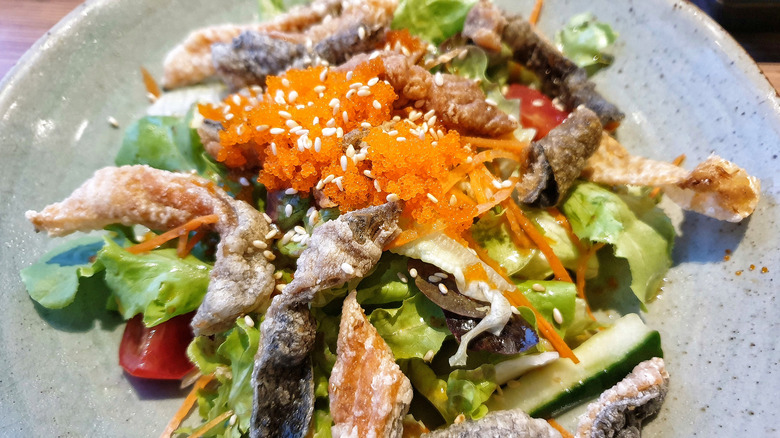Save Your Leftover Salmon Skin For A Versatile, Textured Salad
If there's any silver lining to the record-breaking inflation at the grocery store lately, it's how people are finding ways to use all the food they buy. Food waste is a huge environmental problem and also can be a disaster for your grocery budget. Nearly 40% of the food in America goes to waste, according to Feeding America; StudyFinds cites a survey that found the average American wastes around $3,000 a year on unused groceries. If you want to save a few dollars and make something delicious out of food scraps rather than throwing them away, a great place to start is to save your salmon skin.
Salmon skin is edible — and it's a staple at Japanese restaurants. When it's broiled, salmon skin becomes crispy, salty, and satisfying — and is perfect on top of a fresh green salad. One perk is that you don't need special skills to make crispy salmon skin. This ingredient is also very nutritious: According to Medical News Today, it is packed with omega-3 fatty acids. Salmon skin not only makes a salad taste better and adds some crunch, but it also brings vitamins, minerals, and extra protein to the dish to keep you feeling satisfied for longer. All you need is a couple of ounces of salmon skin, some fresh salad veggies, and a good dressing.
How to separate the skin from salmon
If you want to try using salmon skin in a salad, buy salmon with its skin on the next time you go to the fishmonger; many filets will already have it removed. When you get the fish home, separate the meat from the skin using a long, sharp knife. Lay the fish flat on a cutting board, then place your knife against one side of the fish and slice a thin strip of the meat away from the skin to create a flap. You'll use this flap to steady the fish to help get the rest of the skin off.
Next, slide your knife between the skin and the meat, keeping it flat and parallel to the work surface. Grab the skin flap with your non-dominant hand and use a kitchen towel or paper towel to help grip the skin while you pull your knife slowly back and forth in the other direction until you get to the other side of the filet.
Once you've separated the skin from the salmon meat, cut it into strips, rub it with olive or avocado oil, season it with salt and pepper, and lay it flat on a sheet pan lined with parchment paper or on a piece of foil. Now you can broil it until the skin is browned and crisp, which takes 3 or 4 minutes under the broiler on high – but you can also use a toaster oven.
Assemble your salmon skin salad
Once the salmon skin is ready, you can assemble your salad with only a few other ingredients: spring mix greens, cucumbers, and cherry tomatoes. You can also add thinly-sliced raw onions, daikon radish sprouts, and bonito flakes, but the salad will still be great without them. Arrange all your vegetables in a salad bowl, toss the ingredients with your dressing of choice, and put the salmon skin on top like you would with croutons.
One dressing option is to buy a store-bought bottle with traditional Japanese flavors like ginger, rice wine vinegar, and soy sauce. Or, make your own using a ponzu sauce, which is made with equal parts citrus juice and soy sauce, as a base. Add some olive oil, ginger, and fresh chives or green onions to your ponzu, shake it together, and you've got the perfect salad dressing.
If you don't eat all your salmon skin or want to meal-prep for the week, the USDA says you can store cooked seafood for two to three days in the refrigerator. When you're ready to use it, give it a quick 30-second refresh under the broiler to make it crisp again, and it will be ready for the next salad. However, salmon skin is a delicious, snackable treat you'll probably want to eat while it's hot and fresh.


